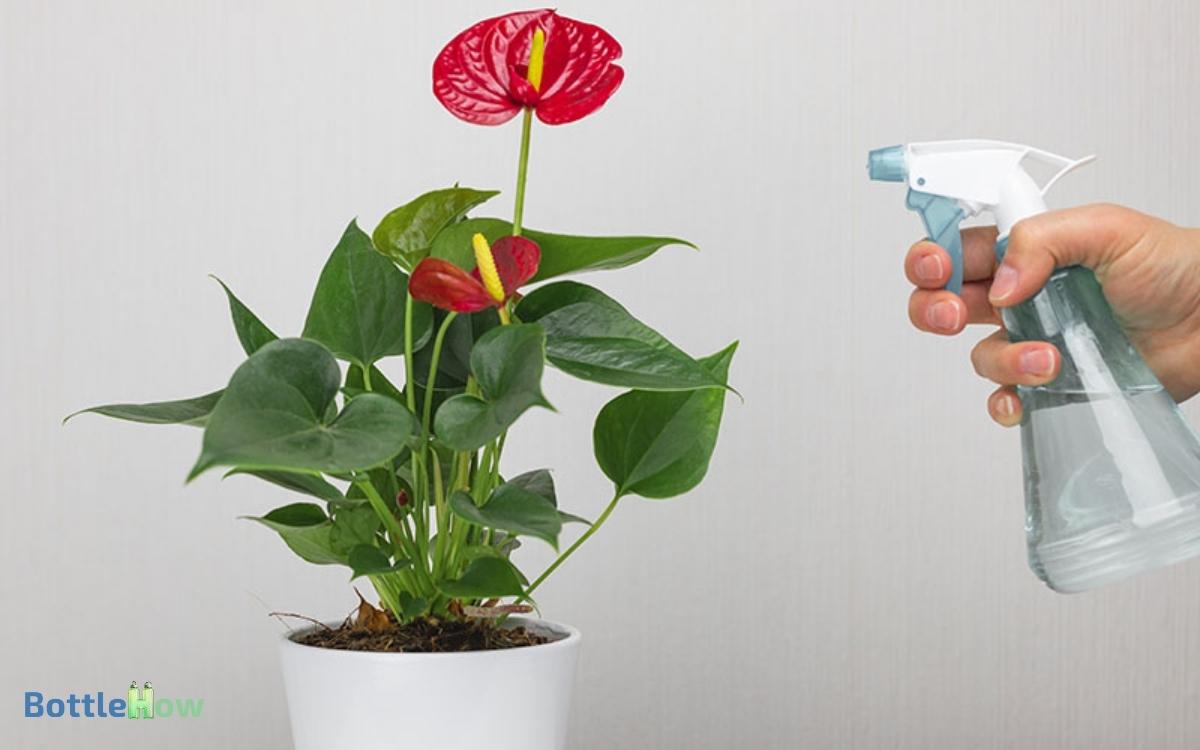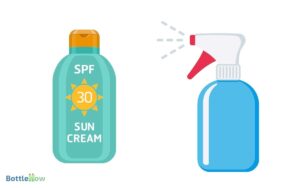Spray Bottle to Water Plants: Find Out Here!
Using a spray bottle to water plants guarantees consistent water distribution and minimizes overwatering, helping to prevent root rot.
Choose a spray bottle with an adjustable nozzle for various spray patterns and an ergonomic design to reduce hand fatigue. Maintain an ideal distance of 12-18 inches while spraying to evenly distribute a fine mist.
Use distilled or filtered water to avoid mineral buildup on foliage. Misting frequency should align with your plant species and current humidity levels to maximize photosynthesis and hydration.
Cleaning your spray bottle regularly ensures peak functionality and prevents contamination. Learn more to perfect your misting technique.

Key Takeaways
Benefits of Spray Bottles
Harnessing the precise control offered by spray bottles, you can guarantee uniform distribution of water, which is essential for maintaining peak plant health.
Spray bottles facilitate ideal foliar feeding by delivering micronutrient solutions directly to the plant’s leaf surfaces, enhancing photosynthetic efficiency.
With their fine mist setting, you can simulate natural humidity, vital for orchids and tropical species.
Additionally, spray bottles reduce the risk of overwatering, which can lead to root rot and other detrimental conditions.
By atomizing water into smaller droplets, you secure better absorption and minimize water waste.
This method allows you to target specific areas, such as new growth or pest-prone zones, thereby optimizing your plant care regimen.
Your precision in watering translates to healthier, more vigorous plants.
Choosing the Right Spray Bottle
To maximize the benefits of spray bottles for plant care, you must meticulously select a spray bottle that features adjustable nozzles and ergonomic design to guarantee efficient and precise water delivery.
Opt for a model with a variable spray pattern, allowing you to switch between a fine mist and a targeted stream. This versatility guarantees ideal hydration while minimizing water waste.
Look for ergonomic handles that reduce hand fatigue, especially if you’re caring for numerous plants.
High-quality materials, like durable plastics or stainless steel, provide longevity. A transparent bottle enables easy monitoring of water levels, ensuring timely refills.
How Often to Mist
Determining the best misting frequency for your plants involves understanding their specific humidity requirements and environmental conditions.
Plants with higher humidity needs, such as tropical species, benefit from daily misting. Conversely, plants adapted to arid climates may require misting only occasionally.
Consider these factors:
- Plant Type: Assess the natural habitat of your plant. Tropical plants like ferns and orchids require frequent misting, while succulents prefer less.
- Environmental Conditions: Monitor ambient humidity levels using a hygrometer. Adjust misting frequency to maintain ideal humidity around 40-60% for most plants.
- Seasonal Variations: Increase misting in winter when indoor heating reduces humidity, and reduce it in summer if ambient humidity is higher.
Best Plants for Misting
When selecting the best plants for misting, you’ll want to focus on species that thrive in high humidity environments and possess delicate foliage.
Ideal choices include tropical plants such as ferns and orchids, which have evolved to absorb moisture through their leaves.
Additionally, consider humidity-loving species like Calatheas and Fittonias that exhibit enhanced growth and vibrant coloration with regular misting.
Ideal Indoor Plant Choices
Selecting the best indoor plants for misting involves understanding their natural habitats and specific moisture requirements. You’ll want to choose species adapted to high humidity and consistent moisture.
Here are three ideal choices:
- Ferns: These plants, particularly Boston Ferns (Nephrolepis exaltata), thrive in high humidity and require regular misting to maintain frond vitality and prevent desiccation.
- Calatheas: Known for their vibrant foliage, Calatheas (Calathea spp.) demand a humid environment to prevent leaf curling and browning edges, making misting essential.
- Orchids: Epiphytic orchids, such as Phalaenopsis, absorb moisture through aerial roots and benefit greatly from misting to simulate their natural tropical rainforest conditions.
Humidity-Loving Species
For ideal growth and health, certain plant species require environments with high humidity levels, and misting can help replicate these conditions effectively.
Species such as Calathea, Maranta, and Alocasia exhibit hygroscopic needs due to their tropical origins.
Their stomatal conductance and leaf morphology are adapted for moist atmospheres, necessitating regular misting to prevent desiccation.
Utilize a spray bottle to deliver fine water droplets, ensuring uniform coverage without waterlogging the root zone. Maintain a relative humidity of 60-80% for these plants.
Misting not only aids in transpiration but also mitigates the risk of spider mites and other xerophilous pests.
By understanding the specific humidity requirements of these species, you can cultivate a thriving, verdant indoor garden.
Delicate Foliage Options
Several delicate foliage plants thrive with regular misting, benefiting from the fine water droplets that mimic their native humid environments.
By using a spray bottle, you can guarantee these plants receive the precise moisture they need without overwatering.
Consider these top three options:
- Maidenhair Fern (Adiantum spp.): This species requires consistent humidity to maintain its thin, feathery fronds. Misting helps prevent the leaves from browning.
- Nerve Plant (Fittonia albivenis): Known for its vibrant, veined leaves, this plant thrives in high humidity. Regular misting keeps its foliage lush and vivid.
- Orchids (Orchidaceae): Epiphytic orchids, which grow naturally on trees, benefit from misting to simulate dew and rainforest conditions, aiding in aerial root moisture absorption.
Use misting to replicate their ideal micro-environments.
Avoiding Overwatering
Ensuring that you don’t overwater your plants requires a precise understanding of their specific moisture needs and vigilant monitoring of soil conditions.
Examine the plant’s root zone by inserting a moisture meter; ideal readings should align with the plant’s moisture tolerance levels.
Pay attention to the color and texture of the soil; dark, soggy soil indicates oversaturation. Utilize a spray bottle to deliver controlled hydration, focusing on the root zone rather than indiscriminately wetting the entire plant.
Adjust your watering frequency based on environmental factors like humidity, temperature, and light exposure.
By meticulously calibrating your watering regimen, you’ll prevent root rot and other water-related issues, ensuring your plants thrive and flourish.
Proper Misting Techniques
You must maintain a best spray distance of approximately 12-18 inches to guarantee even moisture distribution without waterlogging the foliage.
Misting frequency should be calibrated based on plant species and ambient humidity levels, typically ranging from daily to bi-weekly intervals.
Utilize distilled or dechlorinated water to prevent mineral buildup and ensure the health of sensitive plants.
Optimal Spray Distance
Achieving the ideal spray distance for misting plants involves maintaining a range of 6 to 12 inches to guarantee uniform distribution and effective absorption.
This range safeguards that droplets are finely dispersed, preventing water from pooling and reducing the risk of fungal growth.
To optimize your misting technique, consider the following:
- Angle of Spray: Hold the bottle at a 45-degree angle to maximize coverage and minimize runoff.
- Nozzle Adjustment: Set the nozzle to a fine mist setting to produce smaller droplets, which are more easily absorbed by plant tissues.
- Movement: Continuously move the spray bottle in a sweeping motion to ensure all parts of the plant receive equal moisture without oversaturating any one area.
Frequency of Misting
Determining the ideal frequency of misting requires an understanding of each plant species’ specific humidity needs and environmental conditions. You’ll need to take into account factors like ambient humidity, temperature, and plant type.
For instance, tropical plants thrive with daily misting due to their natural humid habitats. Conversely, succulents and cacti, adapted to arid environments, require minimal misting, perhaps once a week or even less. Use a hygrometer to measure ambient humidity levels accurately.
Adjust the misting frequency to maintain the most suitable relative humidity, generally between 40-60% for most houseplants. Avoid over-misting, as excess moisture can lead to fungal growth and root rot.
Water Quality Importance
Guaranteeing ideal water quality for misting involves using distilled or filtered water to prevent mineral build-up and potential harm to sensitive plant tissues.
You’ll want to avoid tap water, as it often contains chlorine, fluoride, and other dissolved salts that can accumulate and damage plant cells. Consistently maintaining high water quality guarantees optimal hydration and nutrient uptake.
Here are three essential steps for proper misting techniques:
- Use a fine mist setting: This allows for even distribution of water droplets, minimizing the risk of over-saturation.
- Perform regular water quality checks: Test for pH and total dissolved solids (TDS) to ensure water remains within safe parameters.
- Clean the spray bottle regularly: Prevent microbial growth and residue build-up by sanitizing your equipment periodically.
DIY Plant Sprays
Crafting your own plant sprays involves selecting specific ingredients that cater to your plant’s unique needs, such as neem oil for pest control or diluted seaweed extract for growth enhancement.
To formulate a neem oil spray, combine 1 teaspoon of neem oil, 1/2 teaspoon of liquid soap as an emulsifier, and 1 liter of water.
For a seaweed extract spray, dilute 1 tablespoon of seaweed extract in 1 liter of water. Guarantee thorough mixing to achieve uniform distribution of active compounds. Apply using a fine mist setting to cover foliage evenly.
Regular application, adhering to a bi-weekly schedule, optimizes nutrient absorption and pest deterrence. Always tailor your formulations to address specific plant requirements, ensuring peak growth and health.
Cleaning Your Spray Bottle
To maintain peak functionality and prevent cross-contamination, thoroughly rinse your spray bottle with warm, soapy water after each use. This practice guarantees that residual chemicals or organic matter won’t affect future plant care.
Follow these steps for the best cleaning:
- Disassemble the Spray Mechanism: Remove the nozzle and tube to access all internal components.
- Soak and Scrub: Submerge parts in a solution of warm water and mild detergent, scrubbing with a small brush to remove any deposits.
- Rinse and Dry: Rinse each part thoroughly under running water and allow them to air dry completely before reassembling.
Troubleshooting Common Issues
If your spray bottle isn’t functioning properly, confirming the root cause requires systematic troubleshooting.
First, inspect the nozzle for obstructions. Detritus can impede fluid dynamics, causing irregular spray patterns. Use a fine needle to dislodge any particulate matter.
Next, examine the pump mechanism. Depress the trigger and observe if the piston compresses and retracts uniformly; any deviations may indicate mechanical failure.
Check the suction tube for air leaks or blockages, which can compromise hydraulic pressure. Make sure the bottle is tightly sealed, as air ingress disrupts pressure equilibration.
Finally, verify the liquid viscosity. High-viscosity solutions may require dilution to optimize spray performance.
Additional Tips and Tricks
Enhancing your spray bottle technique involves precise control to prevent overwatering, ensuring each plant receives adequate hydration without excess.
Utilize fine mist settings to reach challenging areas like undersides of leaves, promoting uniform moisture distribution.
Regularly monitor soil moisture levels to adjust your watering frequency accordingly, maintaining peak plant health.
Efficient Watering Techniques
Properly utilizing a misting spray bottle can greatly enhance hydration efficiency by guaranteeing even water distribution and minimizing overwatering risks.
To maximize efficiency, you should consider the following techniques:
- Fine Mist Settings: Use the spray bottle’s fine mist setting to create tiny water droplets, increasing surface area contact and promoting uniform absorption across the plant’s foliage.
- Targeted Spraying: Direct the mist towards the undersides of leaves where stomata are mainly located. This optimizes gas exchange and enhances transpiration, crucial for plant health.
- Timing: Mist plants during early morning or late afternoon. This reduces evaporation rates, allowing for ideal water uptake while preventing fungal growth due to prolonged moisture exposure.
These techniques ensure your plants receive the precise hydration they need.
Avoid Overwatering Plants
Maintaining ideal soil moisture levels is essential to prevent the detrimental effects of overwatering and promote healthy plant growth.
Use your spray bottle to provide controlled, uniform moisture. Aim for the root zone, ensuring the water penetrates the top 1-2 inches of soil. This allows for best capillary action and nutrient absorption.
Monitor soil moisture using a hygrometer or simply insert your finger to check dampness. Avoid waterlogging; it disrupts oxygen supply to roots, leading to root rot.
Employ a balanced watering schedule, adjusting frequency based on plant species, soil type, and environmental conditions.
Utilizing a well-draining potting mix can enhance aeration and prevent excess water retention, ensuring your plants thrive.
Reaching Difficult Spots
How can you effectively reach those hard-to-access areas of your plants using a spray bottle? Precision and technique are paramount.
Employ these three strategies to guarantee thorough hydration:
- Adjustable Nozzle: Utilize a spray bottle with an adjustable nozzle to modify the spray pattern. A fine mist setting can penetrate dense foliage, ensuring uniform water distribution without disturbing delicate leaves.
- Angled Application: Hold the spray bottle at various angles. This technique allows you to target undersides of leaves and other hidden spots, promoting extensive coverage and reducing the risk of pests.
- Extension Wand: Attach an extension wand to your spray bottle. This tool increases your reach, making it easier to water hanging plants or those in tight corners.
Conclusion
Incorporating a spray bottle into your plant care routine offers precision and adaptability. While misting provides necessary hydration for some species, it’s important to avoid overwatering, which can lead to root rot. Using a spray bottle for misting plants allows you to control moisture levels and create a humid environment suited for tropical species. However, it’s essential to research your plant’s specific needs, as some varieties may be sensitive to excess moisture on their leaves. Regularly cleaning your spray bottle also helps prevent bacterial growth, ensuring your plants stay healthy.
By selecting an appropriate spray bottle and understanding each plant’s needs, you enhance their growth environment.
Contrarily, neglecting these details may harm your plants. Consistent maintenance and troubleshooting promote excellent plant health, blending science with art in your botanical endeavors.






